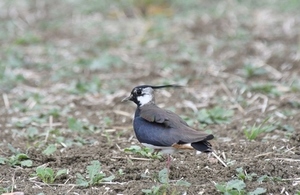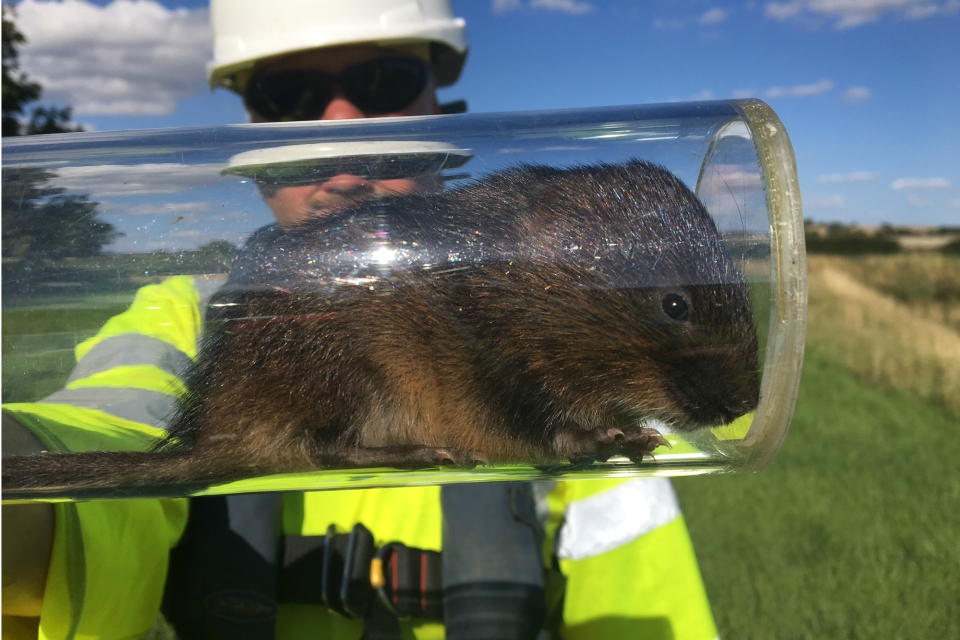Biggest road upgrade leads the way on environment
Moving protected species, creating new habitat the size of 269 rugby pitches and taking traffic for two and a half million tonnes of construction materials off the road are just some of the ways that a major project to upgrade the A14 in Cambridgeshire is caring for the environment.

One of the wild bird species living alongside the A14 (lapwing)
The biggest road project currently in construction in the UK is aiming to leave a positive footprint on the local environment once completed by the end of 2020.
People living and travelling in South Cambridgeshire will by now be familiar with the scale of the A14 Cambridge to Huntingdon project just by looking at the great number of yellow lorries and diggers working away along the sides of the existing A14 and A1, and the size of the new structures emerging along the route.
Less obvious but central to the project is the industry-leading care for the environment that the team is delivering while building the new road.
Patrick Howard, ecology lead for the A14 Cambridge to Huntingdon project for Highways England, explains:
An important part of any road construction project is the planning of environmental mitigation so that, by the time a project is completed, its footprint on the surrounding natural environment is as small as possible.
Protecting the environment now and in the future is one of the golden threads that runs through all aspects of the scheme, from design to construction, project management to efficiency and delivering value for taxpayers’ money. !!n What the A14 team is doing in terms of both environmental mitigation and environmentally-minded project management goes well above and beyond the usual requirements. It sets the standard high in terms of reducing the overall impact of a road scheme on the local environment during construction and after the scheme completion.
Pat continues:
We began thinking about the environment at a very early stage in the project, well before construction started.
There are a number of things we have to do by law, like survey the land where the road will be built to assess how the scheme might affect wildlife, or talk to environmental organisations to get their advice and give them the opportunity to feedback on our proposals.
And we have to look after protected wildlife species such as great crested newts, water voles, bats, badgers and a number of birds that breed on the site of the scheme.
But we’ve also decided to build into the project ways to minimise our environmental impact now and to leave a positive legacy for the future.

One of the ecologists at work releasing some of the water voles into their new habitat in August 2017
Initiatives include: creating 271 hectares of new, connected habitats for wildlife, replanting trees at a ratio of two trees planted for every one felled, gathering rare wildflower seeds and specimens to replant after the end of construction, using renewable energy where possible, and making the most of naturally-occurring materials on site to build the road – more can be found in the list of facts below:
Plants and trees
- Twice as many trees will be replanted which had to be felled to build the road once the project is finished
- All the vegetation cleared ahead of construction starting, including trees felled, has either been used within the local community or to a biomass facility for energy production locally
- 866,000 plants from 50 different species will be replanted once the scheme is completed
- The trees that will be replanted will be in keeping with existing local woodland and include:
- oak
- field maple
- elm
- hawthorn
- blackthorn
- elder
- A number of rare plant species have been found across the route and have been moved so they can be replanted in the same area along the road verges once the scheme is finished. These include bee orchids, common spotted orchids and slender tare – a rare wildflower found near Girton.
Wildlife
- Ecologists working on the project are caring for a range of protected species along the route including:
- great crested newts
- water voles
- bats
- breeding birds such as yellow wagtail, skylark, corn bunting and yellowhammer
- badgers
- Overall, the scheme will build 1.05 square mile (271ha) of new wildlife habitat across 18 areas around the new road, connecting them where possible to help wildlife move more freely than is currently possible. That’s the equivalent of 269 rugby fields.
- More than 200 bat boxes are being installed to provide additional habitat and help bats during migration.
- 5 barn owl boxes have been installed already and more will be installed by the end of the project. All of the ones currently up have been used for nesting this year and 3 of the birds have successfully reared chicks.
- Two bird species, the grasshopper warbler and Cetti’s warbler, will benefit from additional, newly created habitat
- New habitats are being created at 3 different locations along the scheme for water voles, Britain’s fastest declining wild mammal. The 10 water voles being re-located to their new Alconbury home moved all in over the summer.
- Once the scheme is complete, boxes for kestrels will be installed to nest around borrow pits and balancing ponds.
- Activity around 5 badger setts is being monitored along the route and the team is in the process of deciding how best to help the badgers relocate so they are not disturbed or endangered by the new route.
- The team is trapping great crested newts and relocating them at a safe location until the scheme is complete, and will create 3 new habitats for them when the scheme is closer to completion.
- Hedges with native species found in the local area will be planted near Brampton woods to create corridors and food sources for recently reintroduced dormice.
Energy, water and construction materials
- The project team is trialling hybrid generators, solar powered lights and hydrogen powered vehicles throughout site in an effort to reduce our use of fossil fuels.
- 100% of the energy used across the project compounds comes from renewable energy sources including wind and solar powers.
- Only non-drinking water is being used for construction purposes so as to minimise the impact on the local drinking water supply. The water comes from water treatment plants, the scheme’s borrow pits, and local watercourses (up to a maximum of 20m3 per day).
- Instead of having to source externally the 5 million tonnes of materials needed to build the new road, more than half of it is being supplied from the site itself through borrow pits within site. The project also has onsite concrete batching plants to create the building blocks for the scheme’s 34 bridge and other structures. This means less long-distance transport needs and less energy used. It also means less impact on the busy road network locally.
Work on building the £1.5bn upgrade to the A14 between Cambridge and Huntingdon started in November last year. The project includes widening a total of seven miles of the A14 in each direction (across two sections), a major new bypass south of Huntingdon, widening a three-mile section of the A1 and demolition of a viaduct at Huntingdon, which will support improvements in the town.
For the latest information about the A14 Cambridge to Huntingdon improvement scheme, visit the project page, follow @A14C2H on Twitter and like our Facebook page.
General enquiries
Members of the public should contact the Highways England customer contact centre on 0300 123 5000.
Media enquiries
Journalists should contact the Highways England press office on 0844 693 1448 and use the menu to speak to the most appropriate press officer.